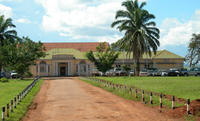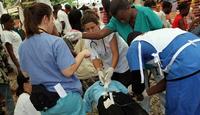-
U.S. not ready for bioterrorism
New report finds that if a major disease incident or bioterrorism attack were to occur today, the United States would not be ready for it; significant local, state, and federal budget cuts have had a negative impact on public health departments’ ability to maintain staff capabilities, and their ability to respond to crises
-
-
GAO: HHS does not have plan for IT pandemic surveillance
The Health and Human Services (HHS) Department has not developed a strategic plan for a national electronic network for public health situational awareness four years after being told to do so by Congress, according to the GAO
-
-
Virulent Haitian cholera strain to dominate the Americas
The high death rate of the Haiti cholera relative to earlier outbreaks in the region (for example, Peru 1991) could partly be because medical care, nutrition, and HIV levels are worse in earthquake- and poverty-stricken Haiti than Peru — but it could also be due to a nastier cholera toxin
-
-
New Jersey lab on the forefront of fighting bioterrorism
A New Jersey company is working on defense against biological warfare; the 3-year $8.2 million contract with the Department of Defense calls for it to develop drug molecules used to combat biological warfare pathogens — centering its research around eight bacterial pathogens (although for security reasons, the list of pathogens has not been made public)
-
-
UN peacekeepers to blame for Haiti cholera, report says
A scientific report prepared for the Haitian and French governments says that Nepalese soldiers — members of the UN peace keeping contingent in Haiti — are the likely source of the cholera epidemic which so far has killed 2,120 people and required medical treatment for 100,000 more; the study found that the source of the outbreak was a Nepalese peacekeeping base, whose toilets contaminated the Artibonite river; the river was the main focus of the outbreak when it began in October, but cholera has since spread throughout the country
-
-
Capitalism to strengthen U.S. response capability to epidemics, bioterrorism
The H1N1 flu pandemic highlighted critical gaps in the response capability of the United States, among them: the United States relies almost entirely on foreign suppliers for influenza vaccines and, perhaps as important, production of vaccines for a novel disease strain can take as long as six months; the U.S. Department of Health and Human Services (HHS) wants to reinvent the U.S. medical countermeasures enterprise, from new doctrines for regulatory approvals to nimble, domestic manufacturing capability developed in partnership with the private sector
-
-
Increasing cooperation between security, health officials
Those in charge of preventing and treating man-made diseases (bioterrorism) and those in charge of preventing and treating naturally occurring epidemics have increased cooperation because of a growing recognition by both sides that only way to monitor the rapidly increasing globalization of “dual-use” biological technology — which can be used in regular research efforts or clandestinely put toward a weapons program — is to pool their resources
-
-
MS drug to lead fight against bioterrorism
A drug already approved for treating multiple sclerosis show promise as a long sought treatment for victims of bioterrorist attack with botulinum neurotoxin — which is 10,000 times deadlier than cyanide and the most poisonous substance known to man
-
-
Northrop Grumman testing autonomous biodetection instruments for BioWatch
DHS has awarded Northrop Grumman a contract to begin field testing a new generation of autonomous biodetection instruments as part of the BioWatch Gen-3 program.; the total potential value of the contract is $37 million over three years
-
-
Report: DHS underestimates risks of accidental pathogen release at Kansas BioLab
Manhattan, Kansas, is the proposed location of a new, $450 million BioLab44 DHS research facility; a National Academy of Sciences panel report says that a risk assessment by DHS of the new facility vastly underestimates the risk of an accidental pathogen release from the lab and the associated costs; the NAS report also said last month’s analysis failed to learn from fifteen major accidental releases of the foot and mouth virus around the world
-
-
Cholera to linger in Haiti for years to come
Worldwide, poor sanitation that spreads cholera and other gut infections accounts for 2.4 million deaths a year, and 6.6 per cent of all life-years lost to disease and disability; the current cholera crisis in Haiti offers a grim example: cholera deaths are climbing sharply in Haiti, after the infection reached the capital, Port-au-Prince, as feared; epidemiologists who have studied other outbreaks predict that hundreds of thousands of Haitians will be stricken by the infection over the next few years as cholera takes hold in the country
-
-
U.S. sees East Africa as front line in bioterrorism war

Africa emerges as the front line in the war against bioterrorism; anthrax killed hundreds of hippopotamuses in Uganda in recent years; in 2008 a Dutch tourist died from Marburg disease after visiting a cave in a national park; in 2007 an Ebola outbreak killed more than twenty people; American officials say that the underlying threat is that lax security at the poorly financed labs that collect and study these and other deadly diseases pose a bioterrorism risk; the rise of Islamist radicals in several countries in East Africa has refocused attention on this region as a frontier in American security interests
-
-
Detecting use of abnormal organisms as bioterror weapons
Organisms have the potential to cause disease, but they can be altered to cause an unrecognized diseases or a process a process that doctors have not associated with that organism; this makes altered forms of bacteria like salmonella or E. coli the potential “bombs” in a bio-terrorist attack, but scientists at Purdue University developed a new way to look at those bacteria; now, West Virginia University is testing its potential
-
-
India to be home to the 7th CDC global disease detection center
One result of President Obama’s visit to India is the agreement to set up a global disease detection centre in India; the center will be part of the global network of detection facilities supervised by the U.S. Centers for Disease Control and Prevention (CDC); the Indian center — the seventh CDC global facility — will monitor deadly pathogens and viruses, outbreak information, coordinate responses, and support the WHO’s Global Outbreak Alert and Response Network to allow rapid identification, confirmation and response to outbreaks of international importance
-
-
Cholera treatment centers set up in Haiti's capital

Port-au-Prince is estimated to be home to between 2.5 million and 3 million people, about half of whom have been living in homeless encampments since the 12 January earthquake ravaged the capital; Port-au-Prince’s pre-earthquake sanitation and drinking water systems were already miserable owing to neglect and indifference by successive Haitian governments, and health experts say that these conditions make the city “ripe for the rapid spread of cholera”
-
- All
- Regional
- Water
- Biometrics
- Borders/Immig
- Business
- Cybersecurity
- Detection
- Disasters
- Government
- Infrastructure
- International
- Public health
- Public Safety
- Communication interoperabillity
- Emergency services
- Emergency medical services
- Fire
- First response
- IEDs
- Law Enforcement
- Law Enforcement Technology
- Military technology
- Nonlethal weapons
- Nuclear weapons
- Personal protection equipment
- Police
- Notification /alert systems
- Situational awareness
- Weapons systems
- Sci-Tech
- Sector Reports
- Surveillance
- Transportation
Advertising & Marketing: advertise@newswirepubs.com
Editorial: editor@newswirepubs.com
General: info@newswirepubs.com
2010-2011 © News Wire Publications, LLC News Wire Publications, LLC
220 Old Country Road | Suite 200 | Mineola | New York | 11501
Permissions and Policies
Editorial: editor@newswirepubs.com
General: info@newswirepubs.com
2010-2011 © News Wire Publications, LLC News Wire Publications, LLC
220 Old Country Road | Suite 200 | Mineola | New York | 11501
Permissions and Policies
